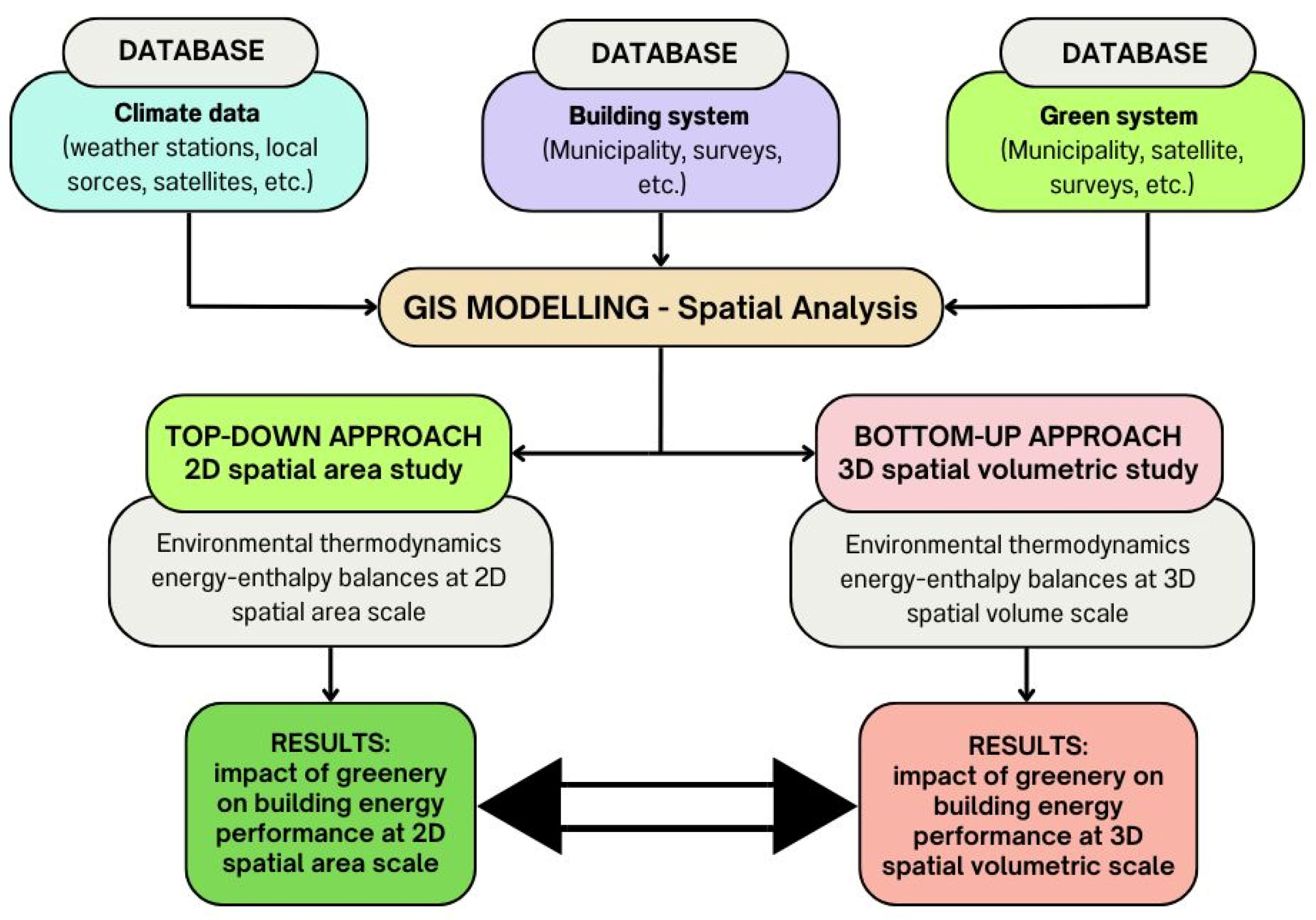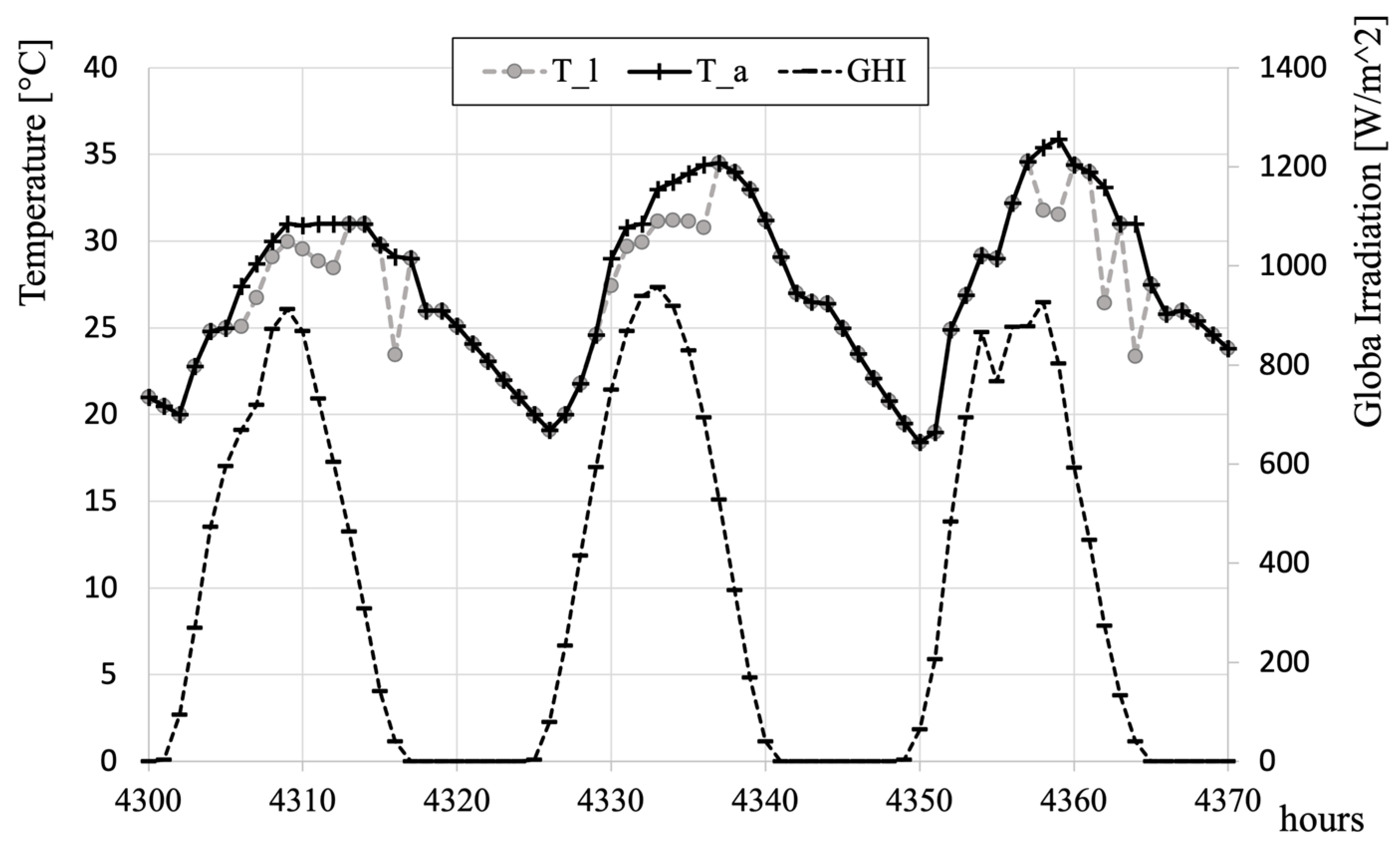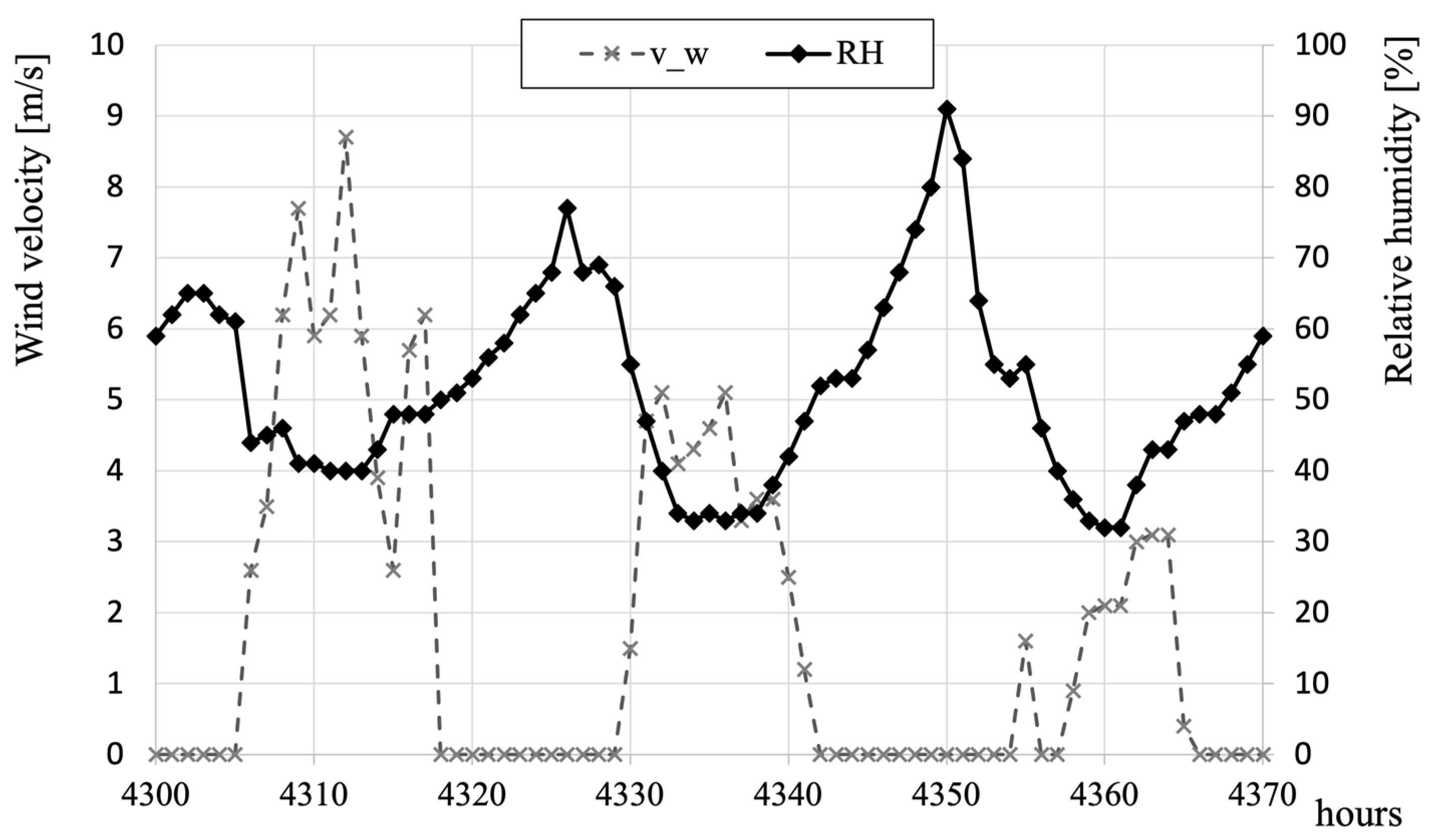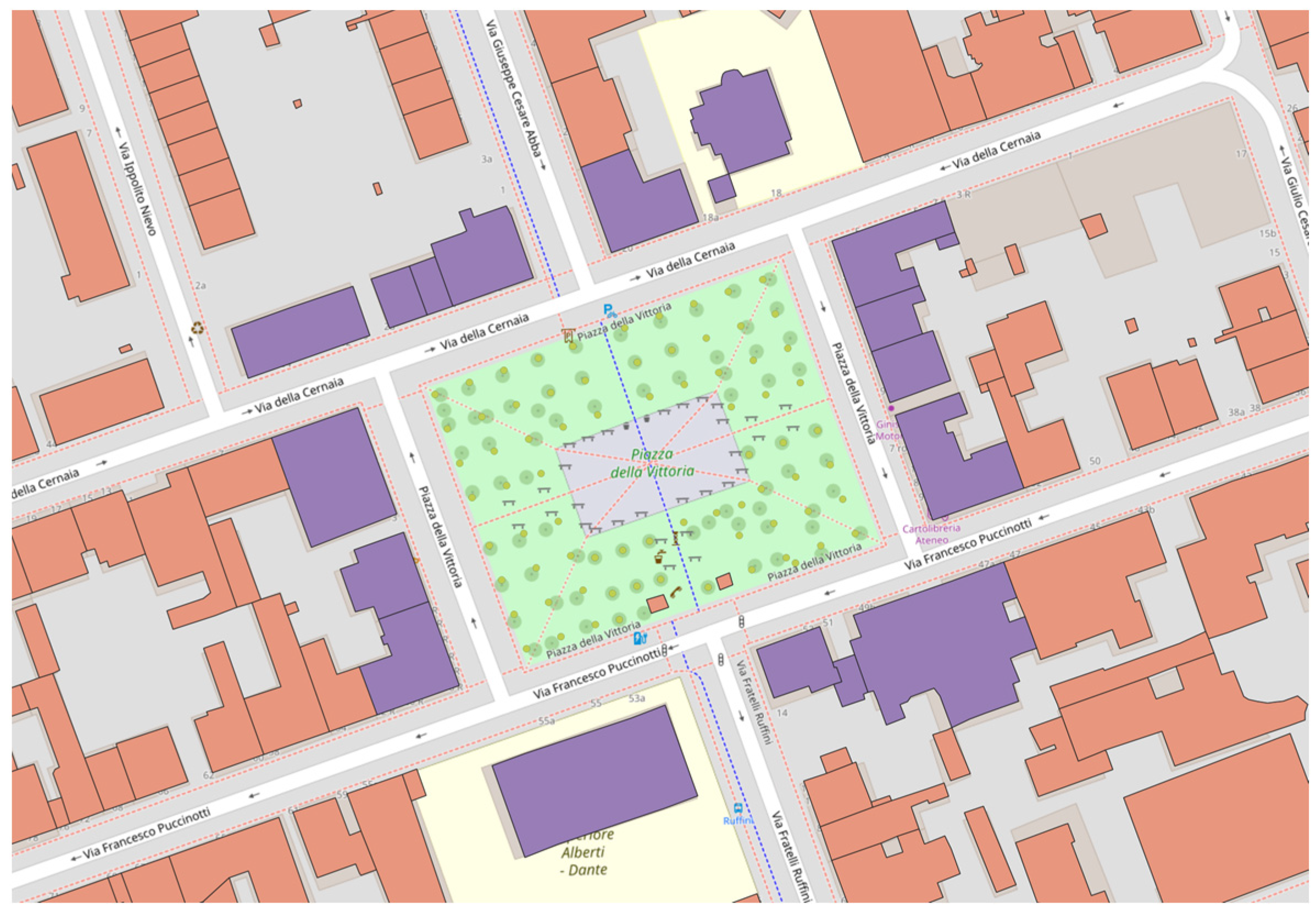Green System Effects on Energy Environmental Sustainability of Urban Built-Up Areas
Abstract
1. Introduction
2. Materials and Methods
- The “top-down” method considers the urban context as a 2D footprint of greenery and buildings, or at a two-dimensional areal scale. It is of immediate application and is applied to evaluate the enthalpy variations on a large scale in the summer period, even when the information on buildings is not complete or scarce.
- The “bottom-up” method considers the urban context and the volumetric morphology with details on the buildings, i.e., it is at a 3D volumetric areal scale. It requires a more in-depth analysis at the district level to evaluate the variation of air enthalpy connected to the air exchange volumes for the summer cooling of each building.
- is the incident solar radiation on a specific site and at a specific hour of the day;
- α is the absorption coefficient of solar radiation (0.80 as suggested [50]);
- ε is the emissivity coefficient in the infrared (0.96 [50]);
- Tl is the surface temperature of the leaves (°C);
- k1 equal to 9.14 Jm−2s−1/2–11 °C−1 and k2 equal to 200 s1/2−1m−1 are empirical coefficients as suggested in [50];
- vw is the wind speed (m/s);
- Dl is the characteristic dimension of the leaves in the wind direction (0.05 m);
- Ta is the ambient temperature (°C);
- Ll is the latent heat of vaporization at the surface temperature of the leaves (J/kg);
- vl is the vapor density at the surface temperature of the leaves (kg/m3);
- RHa is the relative humidity of the air (%);
- va is the vapor density at the ambient temperature (kg/m3);
- rl is the evaporation resistance of the leaves (ranging from 200 to 2000 s/m as suggested in [50]);
- Wl is the characteristic dimension of the leaves in the direction transverse to the wind (0.05 m).
- a is air density (kg/m3);
- V is the volume of the individual building (m3);
- n is the number of air exchanges per hour (volumes/h), expressed in 1/s;
- Δh is the specific air enthalpy variation between the standard weather condition and the one obtained through the leaf temperature (ha − hl) expressed in J/kg.
3. Application and Results
- The leaf surface temperature tends to be always lower than the external air temperature, except in some particular conditions, i.e., when the relative air humidity is very high (RHa > 0.8);
- Without solar radiation, the whole leaf coverage reaches the equilibrium condition with the surrounding environment;
- An increase in wind speed leads to an increase in thermal exchange between the leaf surface and the air, reducing the achievable temperature difference (e.g., with Ta equal to 28 °C and all the other parameters constant, if wind speed varies from 1 to 10 m/s, Tl changes from 27.4 °C to 27.7 °C);
- If the wind speed is zero, one term of the balance becomes meaningless;
- The GHI (Global Horizontal Irradiation, expressed in W/m2) data must be used because it is not possible to accurately determine the average solar radiation striking leaves oriented in different directions; accordingly, for greenery analysis through the GEOscope Observatory platform [55], the leaf surface is considered as a ground area, i.e., green coverage.
4. Discussion
5. Conclusions
Author Contributions
Funding
Data Availability Statement
Conflicts of Interest
Nomenclature
| Al | Leaf surface (m2) |
| cpa | Specific heat of air at constant pressure (kJ/kg K) |
| cpv | Specific heat of vapor at constant pressure (kJ/kg K) |
| D | Characteristic dimension of the system (m) |
| Dl | Characteristic dimension of the leaf surface in the direction of the wind (m) |
| Gr | Grashof, dimensionless number (-) |
| hconv | Convective heat transfer coefficient (W/m2 K) |
| h | Specific enthalpy (kJ/kg) |
| ha | Specific air enthalpy at external air temperature (kJ/kg) |
| hl | Specific air enthalpy at leaf surface temperature (kJ/kg) |
| hd | Specific enthalpy of the dry air (kJ/kg) |
| hv | Specific enthalpy of the vapor contained in the air (kJ/kg) |
| k1, k2 | Empirical coefficients provided by [50], respectively, equal to 9.14 Jm−2 s−1/2–11 °C−1 and 200 s1/2−1m−1 |
| La | Latent heat of vaporization at external air temperature (kJ/kg) |
| Ll | Latent heat of vaporization at leaf surface temperature (kJ/kg) |
| n | Number of air changes per hour (volume/h) expressed in (1/s) |
| Nu | Nusselt, dimensionless number (-) |
| Pr | Prandtl, dimensionless number (-) |
| Psa | Saturation pressure at the external air temperature (Pa) |
| Psl | Saturation pressure at the leaves’ surface temperature (Pa) |
| Thermal power reduction within an hour (W) | |
| Q | Total heat released to the air, i.e., air enthalpy variation (kJ/kg) |
| Radiation absorbed by leaves across the entire spectrum (i.e., the product of the mean hemispherical absorption coefficient and the incident solar radiation expressed in W/m2) | |
| Total solar radiation on the horizontal plane (W/m2) | |
| Latent heat (W) | |
| Sensible heat (W) | |
| Ra | Rayleigh, dimensionless number (Gr · Pr) (-) |
| RHa | Relative humidity of the external air (%) |
| RHsat-l | Relative humidity at the saturation temperature value of the leave surface (%) |
| rl | Resistance to evapotranspiration of leaves (s/m) |
| T | Indoor air temperature (°C) |
| Ta | External air temperature (°C) |
| Tl | Surface temperature of leaves (°C) |
| vw | Wind velocity (m/s) |
| V | Building total volume (m3) |
| W | Characteristic dimension of the leaf surface in the transverse direction to the wind (m) |
| xa | Air specific humidity at the external air temperature (kgvapour/kgdry-air) |
| xl | Air specific humidity at the surface temperature of the leaves (kgvapour/kgdry-air) |
| β | Coefficient of thermal expansion (1/K) |
| Δ | Difference |
| ε | Infrared emissivity coefficient (-) |
| λa | Thermal conductivity of the external air (W/m K) |
| μa | Dynamic viscosity (kg/m s) |
| External air density (kg/m3) | |
| Vapor density at the external air temperature (kg/m3) | |
| Vapor density at leaf surface temperature (kg/m3) | |
| σ | Stefan–Boltzmann constant (W/m2 K4) |
References
- Global Alliance for Buildings and Construction (GlobalABC). Beyond Foundations—Mainstreaming Sustainable Solutions to Cut Emissions from the Buildings Sector; Global Alliance for Buildings and Construction (GlobalABC): Paris, France, 2024. [Google Scholar]
- Xi, C.; Ren, C.; Zhang, R.; Wang, J.; Feng, Z.; Haghighat, F.; Cao, S.-J. Nature-based solution for urban traffic heat mitigation facing carbon neutrality: Sustainable design of roadside green belts. Appl. Energy 2023, 343, 121197. [Google Scholar] [CrossRef]
- Rezazadeh, A.A.; Avami, A. An integrated policy approach for sustainable decarbonization pathways of energy system in a city under climate change scenarios. Energy Policy 2024, 195, 114394. [Google Scholar] [CrossRef]
- Parvin, K.; Hossain, M.J.; Arsad, A.Z.; Ker, P.J.; Hannan, M.A. Building energy technologies towards achieving net-zero pathway: A comprehensive review, challenges and future directions. J. Build. Eng. 2025, 100, 111795. [Google Scholar] [CrossRef]
- D’Amato, D.; Droste, N.; Allen, B.; Kettunen, M.; Lähtinen, K.; Korhonen, J.; Leskinen, P.; Matthies, B.D.; Toppinen, A. Green, circular, bio economy: A comparative analysis of sustainability avenues. J. Clean. Prod. 2017, 168, 716–734. [Google Scholar] [CrossRef]
- Marando, F.; Salvatori, E.; Sebastiani, A.; Fusaro, L.; Manes, F. Regulating Ecosystem Services and Green Infrastructure: Assessment of Urban Heat Island effect mitigation in the municipality of Rome, Italy. Ecol. Modell. 2019, 392, 92–102. [Google Scholar] [CrossRef]
- Azmeer, A.; Tahir, F.; Al-Ghamdi, S.G. Progress on green infrastructure for urban cooling: Evaluating techniques, design strategies, and benefits. Urban Clim. 2024, 56, 102077. [Google Scholar] [CrossRef]
- Aleksejeva, J.; Voulgaris, G.; Gasparatos, A. Systematic review of the climatic and non-climatic benefits of green roofs in urban areas. Urban Clim. 2024, 58, 102133. [Google Scholar] [CrossRef]
- Oquendo-Di Cosola, V.; Olivieri, F.; Ruiz-García, L. A systematic review of the impact of green walls on urban comfort: Temperature reduction and noise attenuation. Renew. Sustain. Energy Rev. 2022, 162, 112463. [Google Scholar] [CrossRef]
- Villarreal-Guerrero, F.; Kacira, M.; Fitz-Rodríguez, E.; Linker, R.; Giacomelli, G.A.; Arbel, A.; Kubota, C. Implementation of a greenhouse cooling strategy with natural ventilation and variable fogging rates. Trans. ASABE 2013, 56, 295–304. [Google Scholar] [CrossRef]
- Hami, A.; Abdi, B.; Zarehaghi, D.; Maulan, S. Bin Assessing the thermal comfort effects of green spaces: A systematic review of methods, parameters, and plants’ attributes. Sustain. Cities Soc. 2019, 49, 101634. [Google Scholar] [CrossRef]
- Edeigba, B.A.; Ashinze, U.K.; Umoh, A.A.; Biu, P.W.; Daraojimba, A.I. Urban green spaces and their impact on environmental health: A Global Review. World J. Adv. Res. Rev. 2024, 21, 917–927. [Google Scholar] [CrossRef]
- Cardinali, M.; Pisello, A.L.; Piselli, C.; Pigliautile, I.; Cotana, F. Microclimate mitigation for enhancing energy and environmental performance of Near Zero Energy Settlements in Italy. Sustain. Cities Soc. 2020, 53, 101964. [Google Scholar] [CrossRef]
- Piselli, C.; Di Grazia, M.; Pisello, A.L. Combined effect of outdoor microclimate boundary conditions on air conditioning system’s efficiency and building energy demand in net zero energy settlements. Sustainability 2020, 12, 6056. [Google Scholar] [CrossRef]
- Rahman, M.S.; MacPherson, S.; Lefsrud, M. A study on evaporative cooling capacity of a novel green wall to control ventilating air temperature. J. Build. Eng. 2023, 77, 107466. [Google Scholar] [CrossRef]
- Wu, Y.; Patuano, A.; Mashhoodi, B.; Lenzholzer, S.; Acred, A.; Narvaez Zertuche, L. How small green spaces cool urban neighbourhoods: Optimising distribution, size and shape. Landsc. Urban Plan. 2025, 253, 105224. [Google Scholar] [CrossRef]
- Balocco, C.; Colaianni, A. Assessment of energy sustainable operations on a historical building. The Dante Alighieri high school in Florence. Sustainability 2018, 10, 2054. [Google Scholar] [CrossRef]
- Ciacci, C.; Banti, N.; Di Naso, V.; Bazzocchi, F. Green strategies for improving urban microclimate and air quality: A case study of an Italian industrial district and facility. Build. Environ. 2023, 244, 110762. [Google Scholar] [CrossRef]
- D’Amato, D.; Korhonen, J. Integrating the green economy, circular economy and bioeconomy in a strategic sustainability framework. Ecol. Econ. 2021, 188, 107143. [Google Scholar] [CrossRef]
- Barradas, V.L. Air temperature and humidity and human comfort index of some city parks of Mexico City. Int. J. Biometeorol. 1991, 35, 24–28. [Google Scholar]
- Bartesaghi Koc, C.; Osmond, P.; Peters, A. Evaluating the cooling effects of green infrastructure: A systematic review of methods, indicators and data sources. Sol. Energy 2018, 166, 486–508. [Google Scholar] [CrossRef]
- Yuan, Y.; Guo, W.; Tang, S.; Zhang, J. Effects of patterns of urban green-blue landscape on carbon sequestration using XGBoost-SHAP model. J. Clean. Prod. 2024, 476, 143640. [Google Scholar] [CrossRef]
- Ling, T.Y.; Chiang, Y.C. Well-being, health and urban coherence-advancing vertical greening approach toward resilience: A design practice consideration. J. Clean. Prod. 2018, 182, 187–197. [Google Scholar] [CrossRef]
- Jamei, E.; Chau, H.W.; Seyedmahmoudian, M.; Mekhilef, S.S.; Sami, F.A. Green roof and energy–role of climate and design elements in hot and temperate climates. Heliyon 2023, 9, e15917. [Google Scholar] [CrossRef]
- Sodoudi, S.; Zhang, H.; Chi, X.; Müller, F.; Li, H. The influence of spatial configuration of green areas on microclimate and thermal comfort. Urban For. Urban Green. 2018, 34, 85–96. [Google Scholar] [CrossRef]
- Puchol-Salort, P.; O’Keeffe, J.; van Reeuwijk, M.; Mijic, A. An urban planning sustainability framework: Systems approach to blue green urban design. Sustain. Cities Soc. 2021, 66, 102677. [Google Scholar] [CrossRef]
- Bilgili, B.C.; Şahin, Ş.; Yilmaz, O.; Gürbüz, F.; Arici, Y.K. Temperature distribution and the cooling effects on three urban parks in Ankara, Turkey. Int. J. Glob. Warm. 2013, 5, 296–310. [Google Scholar] [CrossRef]
- Arzberger, S.; Egerer, M.; Suda, M.; Annighöfer, P. Thermal regulation potential of urban green spaces in a changing climate: Winter insights. Urban For. Urban Green. 2024, 100, 128488. [Google Scholar] [CrossRef]
- Shan, L.; He, S. The role of peri-urban parks in enhancing urban green spaces accessibility in high-density contexts: An environmental justice perspective. Landsc. Urban Plan. 2025, 254, 105244. [Google Scholar] [CrossRef]
- Vasconcelos, L.; Langemeyer, J.; Cole, H.V.S.; Baró, F. Nature-based climate shelters? Exploring urban green spaces as cooling solutions for older adults in a warming city. Urban For. Urban Green. 2024, 98, 12840. [Google Scholar] [CrossRef]
- Sarkar, C.; Webster, C.; Pryor, M.; Tang, D.; Melbourne, S.; Zhang, X.; Jianzheng, L. Exploring associations between urban green, street design and walking: Results from the Greater London boroughs. Landsc. Urban Plan. 2015, 143, 112–125. [Google Scholar] [CrossRef]
- Gunawardena, K.R.; Wells, M.J.; Kershaw, T. Utilising green and bluespace to mitigate urban heat island intensity. Sci. Total Environ. 2017, 584–585, 1040–1055. [Google Scholar] [CrossRef]
- Yang, F.; Yousefpour, R.; Hu, Y.; Zhang, Y.; Li, J.; Wang, H. Assessing the efficiency of urban blue-green space in carbon-saving: Take a high-density urban area in a cold region as an example. J. Clean. Prod. 2024, 479, 144017. [Google Scholar] [CrossRef]
- Vidal, D.G.; Teixeira, C.P.; Fernandes, C.O.; Olszewska-guizzo, A.; Dias, R.C.; Vilaça, H.; Barros, N.; Maia, R.L. Patterns of human behaviour in public urban green spaces: On the influence of users’ profiles, surrounding environment, and space design. Urban For. Urban Green. 2022, 74, 127668. [Google Scholar] [CrossRef]
- Yungstein, Y.; Helman, D. Cooling, CO2 reduction, and energy-saving benefits of a green-living wall in an actual workplace. Build. Environ. 2023, 236, 110220. [Google Scholar] [CrossRef]
- Sun, L.; Xie, C.; Qin, Y.; Zhou, R.; Wu, H.; Che, S. Study on temperature regulation function of green spaces at community scale in high-density urban areas and planning design strategies. Urban For. Urban Green. 2024, 101, 128511. [Google Scholar] [CrossRef]
- Abu Qadourah, J. Energy efficiency evaluation of green roofs as a passive strategy in the mediterranean climate. Results Eng. 2024, 23, 102519. [Google Scholar] [CrossRef]
- Huang, J.; Kong, F.; Yin, H.; Middel, A.; Liu, H.; Meadows, M.E. Green roof effects on urban building surface processes and energy budgets. Energy Convers. Manag. 2023, 287, 117100. [Google Scholar] [CrossRef]
- Li, Y.; Fan, S.; Li, K.; Zhang, Y.; Dong, L. Microclimate in an urban park and its influencing factors: A case study of Tiantan Park in Beijing, China. Urban Ecosyst. 2021, 24, 767–778. [Google Scholar] [CrossRef]
- Wu, Z.; Zhou, Y.; Ren, Y. Green space-building integration for Urban Heat Island mitigation: Insights from Beijing’s fifth ring road district. Sustain. Cities Soc. 2024, 116, 105917. [Google Scholar] [CrossRef]
- Bartesaghi Koc, C.; Osmond, P.; Peters, A.; Irger, M. A Methodological Framework to Assess the Thermal Performance of Green Infrastructure Through Airborne Remote Sensing. Procedia Eng. 2017, 180, 1306–1315. [Google Scholar]
- Obriejetan, M.; Krexner, T. Remote sensing-based evapotranspiration modeling for urban green spaces: A case study in Vienna. Urban Clim. 2024, 58, 102192. [Google Scholar] [CrossRef]
- Jia, J.; Zlatanova, S.; Liu, H.; Aleksandrov, M.; Zhang, K. A design-support framework to assess urban green spaces for human wellbeing. Sustain. Cities Soc. 2023, 98, 104779. [Google Scholar] [CrossRef]
- European Environmental Agency (EEA). Urban Adaptation to Climate Change in Europe 2016: Transforming Cities in a Changing Climate. Available online: https://www.eea.europa.eu/publications/urban-adaptation-2016 (accessed on 17 December 2024).
- European Commission. The European Green Deal. Available online: https://commission.europa.eu/strategy-and-policy/priorities-2019-2024/european-green-deal_en (accessed on 17 December 2024).
- European Commission. Renovation Wave Strategy. Available online: https://energy.ec.europa.eu/topics/energy-efficiency/energy-efficient-buildings/renovation-wave_en (accessed on 17 December 2024).
- European Commission. Biodiversity Strategies for 2030. Available online: https://environment.ec.europa.eu/strategy/biodiversity-strategy-2030_en (accessed on 17 December 2024).
- Balocco, C.; Petrone, G. Efficiency of Different Basic Modelling Approaches to Simulate Moisture Buffering in Building Materials. Open Constr. Build. Technol. J. 2016, 10, 561–574. [Google Scholar] [CrossRef]
- Balocco, C.; Petrone, G. Heat and moisture transfer investigation of surface building materials. Math. Model. Eng. Probl. 2018, 5, 146–152. [Google Scholar] [CrossRef]
- Gates, D. Physical Processes in Ecosystems; University of Washington, Center for Quantitative Science: Washington, WA, USA, 2020. [Google Scholar]
- ASHRAE. Handbook Fundamentals; SI&IP Editions: Atlanta, GA, USA, 2021. [Google Scholar]
- ASHRAE. Handbook—HVAC Systems and Equipment; SI&IP Editions: Atlanta, GA, USA, 2024. [Google Scholar]
- Holman, J.P. Heat Transfer, 10th ed.; McGraw-Hill: New York, NY, USA, 2010. [Google Scholar]
- F-Chart Software. EES—Engineering Equation Solver. Available online: https://fchartsoftware.com/ees/index.php (accessed on 13 March 2025).
- Regione Toscana. GEOscope Observatory. Available online: https://www.regione.toscana.it/-/geoscopio (accessed on 13 March 2025).
- EN 16798-1:2019; Energy Performance of Buildings—Ventilation for Buildings—Part 1: Indoor Environmental Input Parameters for Design and Assessment of Energy Performance of Buildings Addressing Indoor Air Quality, Thermal Environment, Lighting and Acoustics—M1-6 2019. Slovenian Institute for Standardization: Ljubljana, Slovenia, 2019.
- Balocco, C.; Leoncini, L. The green system: Solutions for environmental protection and CO2 emissions reduction. The example of an existing school building. Ital. J. For. Mt. Environ. 2023, 78, 99–114. [Google Scholar] [CrossRef]
- Decree of the President of the Italian Republic 16 April 2013, n. 74. Regulation Defining the General Criteria for Operation, Operation, Control, Maintenance and Inspection of Thermal Systems for Winter and Summer Air Conditioning of Buildings and for the Preparation of Hot Water for Sanitary Purposes; Decree of the President of the Italian Republic: Rome, Italy, 2013; (13G00114).
- Costa-Filho, E.; Chávez, J.L.; Zhang, H.; Andales, A.A. An optimized surface aerodynamic temperature approach to estimate maize sensible heat flux and evapotranspiration. Agric. For. Meteorol. 2021, 311, 108683. [Google Scholar] [CrossRef]
- Baraldi, R.; Neri, L.; Costa, F.; Facini, O.; Rapparini, F.; Carriero, G. Ecophysiological and micromorphological characterization of green roof vegetation for urban mitigation. Urban For. Urban Green. 2019, 37, 24–32. [Google Scholar] [CrossRef]





| Ta | vw | RHa | rl | |
|---|---|---|---|---|
| W/m2 | °C | m/s | - | s/m |
| 800 | 28 | 5 | 0.6 | 1100 |
Disclaimer/Publisher’s Note: The statements, opinions and data contained in all publications are solely those of the individual author(s) and contributor(s) and not of MDPI and/or the editor(s). MDPI and/or the editor(s) disclaim responsibility for any injury to people or property resulting from any ideas, methods, instructions or products referred to in the content. |
© 2025 by the authors. Licensee MDPI, Basel, Switzerland. This article is an open access article distributed under the terms and conditions of the Creative Commons Attribution (CC BY) license (https://creativecommons.org/licenses/by/4.0/).
Share and Cite
Balocco, C.; Pierucci, G.; Piselli, C. Green System Effects on Energy Environmental Sustainability of Urban Built-Up Areas. Energies 2025, 18, 1640. https://doi.org/10.3390/en18071640
Balocco C, Pierucci G, Piselli C. Green System Effects on Energy Environmental Sustainability of Urban Built-Up Areas. Energies. 2025; 18(7):1640. https://doi.org/10.3390/en18071640
Chicago/Turabian StyleBalocco, Carla, Giacomo Pierucci, and Cristina Piselli. 2025. "Green System Effects on Energy Environmental Sustainability of Urban Built-Up Areas" Energies 18, no. 7: 1640. https://doi.org/10.3390/en18071640
APA StyleBalocco, C., Pierucci, G., & Piselli, C. (2025). Green System Effects on Energy Environmental Sustainability of Urban Built-Up Areas. Energies, 18(7), 1640. https://doi.org/10.3390/en18071640








